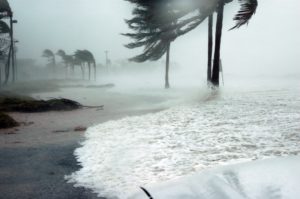As Isaias approaches Florida, states are getting serious about using drones for this hurricane season. In a webinar hosted by AUVSI NC, a panel of experts gave their best advice to state agencies preparing to use UAV for hurricane response.
Drones play a crucial role in allowing public safety agencies to evaluate hurricane damage quickly. Florida Power and Light recently announced that they will implement Percepto’s automated drone system to evaluate damage to the power infrastructure immediately after the storm. State agencies across the country are putting drone programs together to get as many eyes in the sky as possible to plan community response.
In this webinar, experts from NC DOT, FEMA, the FAA, the U.S. Army, and more explained how to get ready to deploy UAS in disasters. You can view the entire recorded webinar at the NC AUVSI website – we’ve highlighted a few of the top insights agencies experienced in the process had to offer about using drones this hurricane season.
Coordination, Safety, and Airspace Awareness
North Carolina Department of Transportation has used drones for response in several hurricanes and major storms.
“Hurricane Florence was really the first coordinated effort for North Carolina,” says Basil Yap, program manager for the NCDOT Division of Aviation UAS Program. “We were trying to get actionable information – images or video – back to the decision makers as quickly as possible. Once the storm moved through, we were using drones to document the damage that had taken place.”
“We were also using livestream as a remote traffic camera, to help get first responders to where they were needed,” Yap explains.
Yap makes the point that during hurricane response, in addition to drones, there are a lot of helicopters in the air. That makes coordination, safety and airspace awareness even more critical – drone programs need to stay out of the way of any manned aircraft response. Yap says that the NC DOT works very closely with the state police department and the local incident commander in affected areas to ensure that their drone programs are coordinated with manned aircraft efforts.
The FAA also takes a critical role in deconflicting drones and manned aircraft for hurricane response. Michael O’Shea is a Program Manager for the FAA’s UAS Integration Office’s, Safety & Integration Division where he serves as liaison, facilitator and resource for both public and civil unmanned aircraft integration efforts. It’s important to pay attention to the FAA’s regulations during the period: they may, for example, keep drones under 200 feet when possible in order to ensure separation from manned aircraft response, O’Shea explains.
Prepare Your Team in Advance
Gary Thompson is the Deputy Risk Management Chief, North Carolina Emergency Management/Risk Management and Chief of the North Carolina Geodetic Survey/Risk Management/NC Emergency Management. Thompson says that making sure that drone pilots are licensed and trained for the mission in advance is critical for success. In North Carolina, for example, people who want to work for the state can apply in advance – that results in a list of pre-qualified resources that have demonstrated the right skills, licenses, and compliance with state regulations.
FAA’s O’Shea concurs. “You need to do some due diligence,” says O’Shea. “You need to make sure not only that [pilots] have a Part 107, but they have the right skills and experience to get the images you need.”
In addition to ensuring that pilots have the right licensing and skills, public safety agencies may need to be aware of additional federal laws. “If you’re a state or local agency, and you hired a person, you’re responsible for that pilot,” O’Shea points out. Other specific laws may also apply. “For agencies flying under a Part 91 COA, they need to realize that if they hire an outside company, federal regulations require that the company work for the agency exclusively for 90 days,” explains O’Shea.
Coordinate with Federal Agencies
Travis Potter is an IT Project Manager in FEMA Region IV, where he has deployed to more than 22 disasters. Potter explains that as a result of the COVID-19 crisis, FEMA has issued a new preliminary damage assessment guide. “Typically, we would have to gather data by having people actually on the streets,” explains Potter. “Now, we’re allowing ‘Desktop damage assessments.’”
A “desktop damage assessment” requires images. Potter explains, however, that this necessitates close coordination with other organizations: “There is no FEMA drone force – so FEMA relies on local public safety agencies to provide the imagery required.”
That close coordination happens well before a disaster strikes. “During blue skies, we establish UAS working groups,” Potter explains. “The purpose of these working groups is to talk about how we can deploy together, talk about the standards for the imagery, and clarify the way that the imagery is going to make its way up to FEMA. In some states, our working groups actually hold exercises.”
Potter recommends that drone pilots interested in participating in response get in touch with the local FEMA office, who may pass them down to the state agencies who will be ultimately responsible for their deployment.
While many agencies are still just beginning to plan on using drones for this hurricane season, the need for drones is already clear. “We’re only going to see UAS become more critical over time,” says Yap.
Miriam McNabb is the Editor-in-Chief of DRONELIFE and CEO of JobForDrones, a professional drone services marketplace, and a fascinated observer of the emerging drone industry and the regulatory environment for drones. Miriam has penned over 3,000 articles focused on the commercial drone space and is an international speaker and recognized figure in the industry. Miriam has a degree from the University of Chicago and over 20 years of experience in high tech sales and marketing for new technologies.
For drone industry consulting or writing, Email Miriam.
TWITTER:@spaldingbarker
Subscribe to DroneLife here.
https://dronelife.com/2020/07/31/drones-for-this-hurricane-season/
 Unmanned Aerial Vehicle The latest drone news
Unmanned Aerial Vehicle The latest drone news





